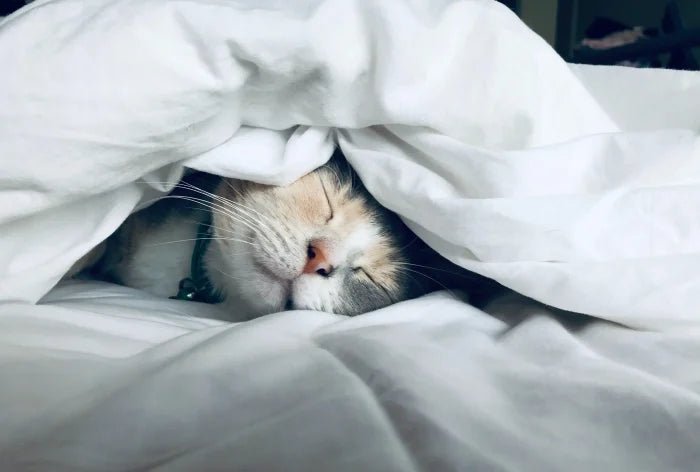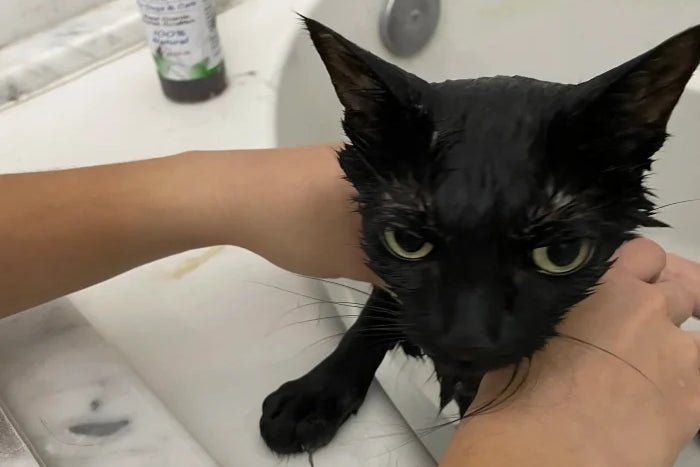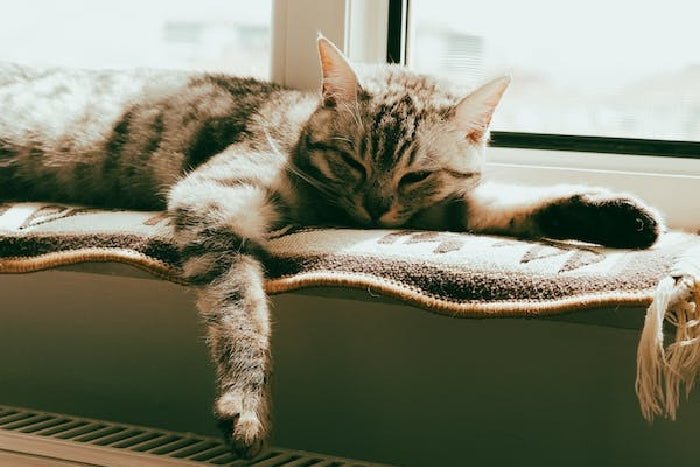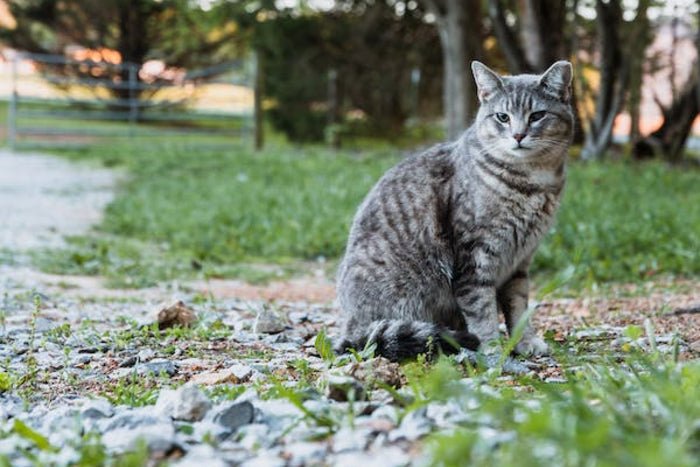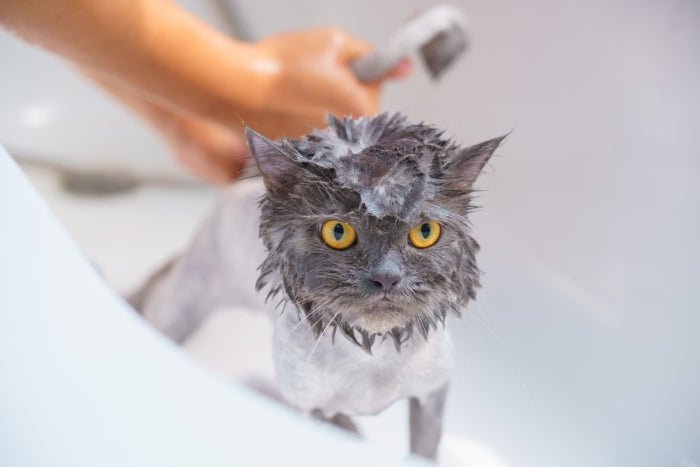Cat Health & Care
Cat Dermatitis – Causes & Cures
Are you a cat parent trying to figure out what is causing your sweet little kitty’s skin irritation? If so, you may be dealing with dermatitis – an inflammation caused most often by allergies. Thankfully, this common issue can usually be managed and cured at home with the help of natural and/or medicinal antibiotics and topical creams. In this blog post, we will discuss some common causes of cat dermatitis and various treatments that could provide relief for your feline friend. What is Dermatitis in Cats? According to Canadian Veterinary Journal, cat dermatitis is an allergic reaction in dogs and cats. It is also termed Atopic Dermatitis or, more generally, skin allergies of cats. Cat dermatitis is a condition in which the skin and fur of cats become inflamed, often resulting in redness, itchiness, and scaly bumps or lesions. The condition has several potential causes, including bacterial or fungal infections, allergies to food or environmental hazards, parasites like fleas or mites, or even underlying medical conditions such as diabetes or kidney disease. Diagnosis typically involves a history of the animal’s symptoms and lifestyle and may be supplemented with blood tests and imaging to rule out secondary causes. As far as epidemiology is concerned, cat dermatitis can occur at any age but is more common in younger cats than in older ones. Poor grooming habits can also increase risk as more bacteria accumulate on the skin’s surface. Treatment depends on the exact cause but often includes nourishing shampoos and topical ointments along with changes in diet and increases in hygiene care to help reduce irritation. Types of Dermatitis in Cats Like all other species, cats can be affected by various skin conditions. Dermatitis is one of the more common issues, and there are three distinct forms: allergic dermatitis, parasitic dermatitis, contact dermatitis, and several food allergies. Allergic dermatitis Allergic dermatitis is generally caused by an immune system reaction to allergies; this may manifest as dry or itchy skin and hair loss. Parasitic dermatitis Parasitic dermatitis often thus arises from flea bites or mites; symptoms typically appear on the head, neck, or back and may include reddened skin or scabs. Contact dermatitis Contact dermatitis originates from exposure to irritants such as certain types of shampoos or detergents; here, it is important to identify the trigger so the cat can receive proper medical attention. Food Dermatitis Food dermatitis is a common health problem seen in cats with an allergic reaction to a certain food or ingredient they’ve ingested. It’s important for pet owners to be aware of the signs of this condition so that they can get their furry friend the help they need as soon as possible. Cats may present several different physical symptoms when suffering from food dermatitis, including excessive scratching and itching, redness or swelling on their lips and around their eyes, and inflamed skin lesions or bumps. Solar Dermatitis Solar Dermatitis in cats is an inflammatory skin condition caused by direct sun exposure. It is often seen in lighter-colored cats or cats with thin fur coats due to increased vulnerability to the ultraviolet radiation of the sun. Symptoms can range from sunburn or itching to crusting and hair loss on exposed areas of the body such as the ears, nose, unprotected areas of legs, nipples, and all other parts which are not covered by fur. Miliary dermatitis Miliary dermatitis in cats is a distressing condition that causes extreme itching and coat loss. It has no single cause and is linked to an allergic hypersensitivity reaction of the skin. However, the trigger can vary greatly. To diagnose miliary dermatitis, a veterinary doctor must assess your cat’s symptom presentation. It is imperative that cat owners recognize these types of dermatitis in their cats to promptly address them with prescribed medical treatments. Causes of Cat Dermatitis There are a variety of causes for this condition, the most notable being allergies to environmental substances such as pollen, dust mites, or insect bites. Other causes include bacterial or fungal skin infections, exposure to certain insecticides or cleaning products; nutritional deficiencies; flea infestations; metabolic disease; hormonal imbalances; exposure to toxins; mange mite infection, or chronic stress. It’s important to remember that cats with existing health problems are more prone to developing dermatitis due to weakened immune systems. To identify the underlying cause of your cat’s symptomatic dermatitis, it will be important for veterinarians to consult your pet’s medical history and perform several diagnostic tests, including allergen testing, skin biopsies, or blood tests. Signs of Feline Dermatitis It’s easily recognized by the presence of redness, itching, scabbing, crusty bumps, and hair loss on the cat’s skin. Other signs to look out for include the following; persistent licking scratching at one particular spot darkening or discoloration of the affected area thickening or scaling of the skin bald patches. barbering (hair pulling) noticeable lesions In more severe cases, you may observe pus-filled sores and wounds on the paws or elsewhere on the body. If you suspect your cat has signs of feline dermatitis, it is important to take them to a vet immediately, as treatment options should be determined based on the underlying cause. How is Cat Dermatitis Diagnosed? Cat dermatitis is typically diagnosed by a veterinarian observing your cat’s visible symptoms and taking a full medical history. It can also be helpful for the veterinarian to perform some additional tests, such as; blood tests urine tests skin scrapings patch testing fur plucks skin swabs fecal analysis biopsies The information gathered from these tests can help the vet to make an accurate diagnosis. For severe cases of dermatitis, further tests may be necessary to rule out other underlying causes of skin problems. This helps the veterinarian formulate the best way to treat your fur baby’s cat dermatitis so they can get back to feeling happy and healthy in no time. Treatments for Cat Dermatitis Cat dermatitis is a relatively common condition in cats, typically triggered by flea bites and other allergies. While most cases can be alleviated with simple lifestyle adjustments, more severe conditions may require additional treatments. Diagnose and eliminate the allergens Non-chemical, organic shampoos are crucial to providing cat allergies and dermatitis relief Eliminating allergens has long been a mainstay in treating dermatitis in cats. So often, the causes are the chemicals in cat grooming products. Helping your cat find relief may be as simple as changing shampoos to one that is natural with healing ingredients such as nettle leaf, red clover, aloe vera etc. Also, simple environmental and dietary changes can help reduce the number of irritants that come into contact with your cat’s skin and relieve symptoms of this skin disorder. By cleaning carpets and furniture more often, using hypoallergenic litter boxes and detergents, regularly grooming your pet with aa non-chemical shampoo, switching to grain-free or hydrolyzed food products, and removing any plants within the house, you can lessen the effects of the allergens for cats. Furthermore, if you have determined what specific substances may be triggering your pet’s allergies, avoiding contact with those items is also advised; learning what is causing their reactions helps tremendously in getting their itchiness under control. Dermatitis is an uncomfortable condition for felines, but by managing the allergen levels in their immediate environment, it can be treated successfully. Antihistamines and corticosteroids Additionally, antihistamines and topical corticosteroids are often prescribed to reduce symptoms such as itching. However, these medications must be carefully monitored for potential side effects and used only under veterinary supervision. Antihistamines help to reduce the allergic response, while corticosteroids reduce inflammation and itching. Both have unique benefits, so it’s important to discuss these options with your vet before administering any medications to your cat. It is also important that you carefully follow the instructions given by your veterinarian when administering these medications to ensure a successful outcome. Oral antibiotics Oral antibiotics are a common treatment for feline dermatitis; when administered properly, they can control secondary bacterial infections. However, appropriate antibiotic therapy must be determined according to the suspected or identified causative agents. Though the drugs used to treat cats’ skin infections are similar to those used in humans, the dosage and duration of treatments involve veterinary expertise. For best results, it is important to adhere closely to instructions regarding administration frequency, amount, and length of treatment. Besides being effective against contagious bacterial dermatitis, systemic antibiotics also reduce inflammation, resulting in a quicker resolution of clinical features and minimizing the risk of recurring episodes. Medicated and organic shampoos An oft-overlooked part of this care is choosing the right shampoo. Thankfully, many options are available. Organic shampoos may provide fast-acting relief without introducing chemicals into their cats’ environment. If your cat goes outdoors and is subject to fleas and ticks, there are non-chemical repellent shampoos available at PawPurity. Dietary supplements Dietary supplements are an important part of managing feline dermatitis; they help support skin health and reduce inflammation. A vet-approved multivitamin with fatty acids is one of the best options – fatty acids promote healthy cellular walls while providing your pet with a wide range of vitamins and minerals. Additionally, supplements that contain ingredients such as turmeric, evening primrose oil, and omega-3 fish oil can be beneficial, as they all help to alleviate dermatitis signs such as itching or flaking skin. When choosing a supplement, always look for one produced by a reputable manufacturer that has identified dosages for cats on labeling to ensure you are giving your pet the correct amount. Finally, consult your veterinarian before starting any nutrition regimen – their expertise is essential in helping you provide adequate care for your cat’s skin condition. FAQs Is cat dermatitis contagious? Cat dermatitis, or inflammation of the skin, can cause a variety of discomforts like itching, redness, and scaling. But is it contagious? There is no evidence that suggests it is contagious between cats, although some infections causing cat dermatitis can be spread from cats to humans. This means that if your cat has been diagnosed with an infectious form of cat dermatitis, protecting yourself and other members of your household should be a priority. Is dermatitis in cats painful? Dermatitis, an inflammation of the skin, can be painful and uncomfortable for cats. As with other animals, cats experience various symptoms, including irritation, redness, itching, and skin dryness. In extreme cases, they may suffer from deep sores or ulcers and an intense burning sensation. It is important to recognize the signs early and visit your veterinarian for treatment to avoid unnecessary suffering. The expert advice from a vet, combined with proper care, nutrition, and hygiene, will ensure that cats remain healthy and happy despite dermatitis. How long does cat dermatitis last? The duration of cat dermatitis depends on the underlying cause and how prompt treatment is given. With early diagnosis, effective anti-inflammatory medication, plus environmental modifications if needed, it is possible to reduce the severity of the flare ups and manage any chronic symptoms over time. Also, in some cases where there is an underlying infection or parasitical cause involved, the full recovery from cat dermatitis may extend for weeks or months, depending on the specific condition prescribed treatment plan. Final Words In conclusion, cat dermatitis is a common skin disorder that can be uncomfortable for cats and their owners. Knowing the various types and causes of the condition and how to treat it can help alleviate its symptoms and keep your cat healthy. It is important to note that prevention is always better than cure, so make sure to minimize potential triggers such as fleas or allergens in your home. Furthermore, regularly monitoring your cat’s skin will help you catch any issues before they become serious.
Learn moreCat Dermatitis: Causes, Symptoms & Natural Treatments
As a first step, you may also try Flea & Tick Shampoo. More often than not, this shampoo has helped pet owners with a mild case of skin mites without a trip to the vet. If the issue persists, then of course, a vet is needed, but since this shampoo can help keep them away after they are long gone, it's worth trying.
Learn moreWhat Shampoo is Safe to Use on Cats?
Cats have thinner, more sensitive skin than dogs, making them vulnerable to harsh shampoos with sulfates, artificial fragrances, and toxic preservatives. PawPurity’s Biogreen Enriched Shampoo, balanced at a 6.2 pH and made with 20 organic botanicals, gently cleanses while soothing irritation and restoring a healthy, shiny coat — naturally.
Learn moreDon’t Put These Essential Oils Near Your Cats!
ALERT! Be aware of the potential risks when using essential oils around your cats. Essential oils can be wonderful for humans, but they can also be dangerous and even fatal for cats. That’s why it’s crucial to know which essential oils are harmful to your furry family member. In this blog post, we’ll discuss the toxic of essential oils that are toxic to cats. Toxic Essential Oils for Cats When it comes to essential oils, some of them can be incredibly dangerous for cats. Many popular essential oils, such as eucalyptus, clove, tea tree, thyme, oregano, wintergreen, and citrus oils, are highly toxic for your furry family members. These essential oils contain phenols and/or hydrocarbons that can cause a range of adverse effects in cats, from skin irritations to burns to liver failure. The most toxic essential oils for cats are; Clove Wintergreen Eucalyptus Tea tree Oregano Clove oil is one of the worst offenders – it contains eugenol, which can cause neurological and respiratory issues in cats. Wintergreen oil contains methyl salicylate, which can lead to gastrointestinal upset. Eucalyptus oil can cause breathing difficulties, while tea tree oil has been linked to liver failure in cats. Thyme and oregano essential oils both contain thymol, which can be especially dangerous if your cat licks their fur after you’ve applied these oils. If you want to use essential oils around your cat, make sure that you always use safe essential oils and never apply them directly to your cat’s fur. What Makes Them Toxic for Cats? When cats inhale certain essential oils, the compounds present in them can cause irritation to their airways. This can result in the cat having difficulty breathing and coughing, which can lead to serious respiratory problems. Additionally, some essential oils contain compounds that can damage the liver and kidneys, resulting in potentially fatal health complications. Even if cats don’t ingest the essential oil, they can absorb it through their skin, making them just as vulnerable to the toxic effects of these oils. Some of the essential oils that are particularly dangerous for cats are eucalyptus, cinnamon, pennyroyal, peppermint, pine, sweet birch, and wintergreen. Many of these oils contain phenols and other compounds that can be toxic to cats when ingested or even just inhaled. Phenols are a type of organic compound that is known to cause irritation and damage to the mucous membranes and can be fatal in certain concentrations. How Can I Tell If My Cat is Having A Reaction to Essential Oils If you’re using the above-mentioned essential oils around your cat, be aware of the signs of a reaction. If you observe any of these symptoms, stop using the oil immediately and consult your veterinarian. Some common signs of a reaction include: Discomfort or pain when coming into contact with the oil Skin irritation or redness Excessive licking or grooming of the area Coughing, sneezing, or wheezing Vomiting or diarrhea Rapid breathing or difficulty breathing Note that some cats may have delayed reactions to these essential oils. If your cat shows any signs of distress, remove them from the area and get them to fresh air. If your cat’s experiences worsen, seek medical attention. Safe Essential Oils for Cats: The short answer is that only a few essential oils are safe for cats, and many of the most commonly used oils are highly toxic. The best way to be sure that you’re not exposing your cat to any potentially harmful toxins is to choose essential oils from the list below of those considered safe for cats. No matter if the oil is safe, it must never be applied directly onto the skin. It MUST be diluted and used in a safe formulation. Lavender oil– This oil is a calming agent that can help soothe cats that suffer from anxiety or stress. Roman chamomile oil – A calming agent that can help cats stay calm. It also has anti-inflammatory properties that may help soothe minor skin irritation. Bergamot oil – Has anti-inflammatory, antibacterial, and antiseptic properties, making it a good choice for treating wounds or helping heal infections. Geranium oil – Often used to treat flea infestations, but it can also be helpful in treating other skin conditions like mange, eczema, and dermatitis. Frankincense oil – This oil is known for its calming properties, making it great for cats that are anxious or stressed out. Sweet Marjoram oil – Has antibacterial and antifungal properties. Calms the body and mind during times of nervousness, panic, and restlessness. Cedarwood oil – Supports skin health and is extremely effective at repelling fleas, which makes it one of the more favorable essential oils to use around your cat. Lemongrass oil – Is a great antifungal and anti-bacterial treatment. It’s also an effective insect repellent. Lemon balm oil – This oil is known for its calming effects and can help relieve stress and anxiety. How Can I Use Essential Oils Safely Around My Cat? Using essential oils around your cat is not a recommended practice. However, if you do decide to use them, there are several ways to do it safely. The first and most important step is to keep all essential oils out of reach of cats. Many essential oils have a strong scent and can cause reactions in cats if they come into contact with them. Make sure that your cat cannot get to the oils or that they are stored in an area where they cannot be reached. Another option is to create a safe space for your cat when using essential oils. You can do this by keeping the area well-ventilated and putting your cat in a room away from where you’re diffusing the oils. This way, your cat won’t be exposed to any dangerous levels of essential oil vapors. Lastly, it’s also important to dilute the essential oil before using it. Diluting the oil with a carrier oil such as almond or jojoba oil will help reduce its potency and make it less likely to cause a reaction in your cat. In conclusion, make sure you take the necessary precautions to protect your cat from harm. Know which essential oils are safe for your cat. Many natural products such as shampoos and flea and tick treatments use essential oils. Proper dilution is absolutely necessary. Natural pet shampoos and other grooming products should contain only a maximum of 1% essential oils and only those that are deemed safe. As a safety precaution, store all essential oils away from cats, and provide your cat with a safe space when diffusing.
Learn moreNatural vs Chemical-Based Cat Shampoos
When it comes to cat grooming products to keep our feline companions clean and healthy, choosing the best cat shampoo is crucial. While cats are known for their meticulous self-grooming habits, there are times when a bath becomes necessary. In this blog, we’ll delve into the world of cat shampoos, focusing on the differences between natural and chemical-based options. As a prime example, we’ll explore the benefits of PawPurity Intensive Nourishing Shampoo and why it stands out among the competition. So, let’s dive in and discover how to provide your cat with the best bathing experience! Why Do Cats Need Baths? Cats are generally self-sufficient in maintaining their cleanliness. Their tongues are designed to remove dirt, debris, and loose hair, helping to keep their coats in excellent condition. However, certain situations may warrant the need for a bath. These can include: Fleas or Ticks: If your cat has encountered pesky parasites, a bath with a suitable shampoo can help eliminate them effectively. Allergies or Skin Conditions: Cats with allergies or skin irritations may benefit from a gentle bath to alleviate discomfort and remove allergens. Dander from cats stay in the air much longer than that from dogs. If you are one of those who are prone to allergies, washing your cat monthly is a good idea to keep the dander in check. Coating with Harmful Substances: Occasionally, cats might get into substances that are toxic or harmful to their health. In such cases, a thorough bath is necessary to remove any traces of the substance. Outdoor Adventures: Cats who frequently explore the outdoors may get excessively dirty, making a bath essential for maintaining hygiene. Understanding Natural vs. Chemical-Based Cat Shampoos When it comes to choosing the best cat shampoo, there are two primary categories: natural and chemical-based options. Here’s a breakdown of the differences between the two: Natural Cat Shampoos: Natural cat shampoos are formulated with ingredients derived from nature. They typically exclude artificial fragrances, dyes, and harsh chemicals, making them milder and gentler on your cat’s skin. Key benefits of natural cat shampoos include: Reduced risk of allergic reactions or skin sensitivities Gentle cleansing without stripping essential oils Environmentally friendly and biodegradable Suitable for cats with sensitive skin or allergies Chemical-Based Cat Shampoos: Chemical-based shampoos often contain synthetic ingredients and additives that provide specific cleansing properties. While they can effectively clean your cat’s fur, it’s important to be cautious about the ingredients used. Key considerations include: Potential risk of skin irritation or allergic reactions Stronger cleansing power, ideal for stubborn dirt or parasites Longer shelf life due to preservatives Suitable for cats without known sensitivities or allergies Why Chemical-Based Shampoos May Be Harmful Several scientific studies have raised concerns about the potential harm associated with chemical-based shampoos for cats. Ingredients such as parabens, sulfates, and artificial fragrances have been linked to skin irritations, allergic reactions, hormonal disruptions, and even cancer in animals. It is crucial to choose a cat shampoo that avoids these potentially harmful ingredients and opt for natural alternatives. Veterinarians Who Support Natural Cat Shampoos Prominent veterinarians, such as Dr. Lisa Pierson and Dr. Karen Becker, advocate for the use of natural cat shampoos. Dr. Pierson is a well-known feline veterinarian and the creator of CatInfo.org, a reputable resource for cat health information. Dr. Becker is a proactive integrative wellness veterinarian, focusing on natural and holistic approaches to pet care. Their expertise and research emphasize the benefits of natural grooming products for cats. It can’t be emphasized enough that choosing the best cat shampoo is highly important in keeping your feline healthy. Introducing PawPurity Intensive Nourishing Shampoo One exceptional cat shampoo that exemplifies the benefits of a natural approach is PawPurity Intensive Nourishing Shampoo. It has been recommended by veterinarians and animal dermatologists throughout the country. This shampoo offers a range of advantages for both your cat’s well-being and the environment. Natural Ingredients: PawPurity Intensive Nourishing Shampoo contains a select blend of natural ingredients such as olive oil, aloe vera oil, calendula, horsetail, nettle, rosemary extract, bamboo and many more plant-based ingredients. Each of the 33 plants serves a purpose to keep your cat’s skin is at its healthiest. Benefits: It contains natural antibiotics, antifungals, and anti-inflammatories, plus a great amount of conditioners and humectants. Using less than 1% essential oils, the scent is herbally fresh, but still light enough to keep the natural oils in balance. These gentle yet effective components provide nourishment, hydration, and soothing properties, ensuring a healthy coat and skin. Hypoallergenic and pH-Balanced: This shampoo is hypoallergenic and pH-balanced to suit your cat’s delicate skin. By avoiding harsh chemicals and artificial fragrances, PawPurity Intensive Nourishing Shampoo minimizes the risk of irritation and allergic reactions, which makes is one of the more popular cat grooming products on the market. Moisturizing and Gentle Cleansing: The intensive nourishing formula of PawPurity shampoo helps retain the natural oils in your cat’s skin, preventing dryness and leaving the coat soft and lustrous. Its gentle cleansing action removes dirt and odors effectively without stripping away natural oils. How Often Should You Bathe Your Cat? The frequency of cat baths depends on various factors, including your cat’s lifestyle, coat type, and specific needs. Generally, most cats do not require frequent baths, as they are proficient self-groomers. However, the following guidelines can help you determine an appropriate bathing schedule: Indoor Cats: Indoor cats that do not frequently encounter dirt or outdoor elements may only need a bath every 4-6 weeks, or as needed for specific situations. Outdoor Cats: Cats who spend time outdoors and get dirty more often may benefit from more regular baths, ranging from every 2-4 weeks. Specific Conditions: Cats with skin conditions, allergies, or medical requirements may need more frequent baths as recommended by a veterinarian. Choosing the Best Cat Shampoo Choosing the best cat shampoo for your furbaby is essential for maintaining its hygiene and overall well-being. Natural shampoos, like PawPurity Intensive Nourishing Shampoo, offer a gentle and nourishing approach to bathing your cat, ensuring a healthy coat and skin. By understanding the differences between natural and chemical-based shampoos, you can make an informed decision and provide your cat with the best care possible. #catshampoos #naturalcatshampoos #chemicalbasedcatshampoos #PawPurityIntensiveNourishingShampoo #catgrooming
Learn moreBenefits of a Natural Shampoo For Cats
Best Natural Shampoo for Cats Cats are notorious for their self-grooming habits, spending a significant part of their day meticulously cleaning themselves. While their grooming skills are impressive, there are times when our feline friends might need a little extra help in the form of a bath. Using a natural shampoo specifically designed for cats can provide numerous benefits, not only for their hygiene but also for their overall health and well-being. In this blog, we will explore why cats need baths and how often, as well as the advantages of using natural shampoo for your furry companions. Why Do Cats Need Baths? Contrary to popular belief, cats are generally capable of keeping themselves clean. However, certain situations may arise where giving them a bath becomes necessary. Here are some common reasons why your feline friend might require a bath: 1. Allergies and Skin Conditions: Cats, like humans, can suffer from allergies and skin irritations. Bathing with a natural shampoo can help soothe their skin and alleviate discomfort caused by allergies or certain skin conditions. 2. Flea Infestations: If your cat becomes infested with fleas, a bath with a specially formulated natural shampoo can help remove the pests and prevent their re-infestation. 3. Eliminating Environmental Toxins: Outdoor cats might come into contact with various pollutants, chemicals, or toxins. Bathing can help remove these harmful substances from their fur and paws, reducing the risk of them ingesting toxins while grooming. 4. Excessive Shedding: During shedding seasons, cats may benefit from a bath to remove loose fur, preventing excessive hairballs and reducing the amount of hair they ingest during grooming. How Often Should You Bathe Your Cat? The frequency of cat baths depends on various factors, including your cat’s lifestyle, breed, and health condition. Generally, cats with no specific health issues or skin conditions may only need a bath a few times a year. However, there are exceptions: 1. Long-Haired Cats: Breeds with long fur, such as Persians or Maine Coons, may require more frequent baths to prevent matting and tangling of their fur. 2. Outdoor Cats: Cats that spend a lot of time outdoors might need more frequent baths, especially if they get dirty or come into contact with potential toxins. 3. Medical Reasons: If your cat is suffering from a skin condition or allergies, your veterinarian may recommend a bathing schedule as part of their treatment plan. In any case, it is crucial to ensure that you use the best pet shampoo designed for felines and as natural and gentle as possible. The Advantages of Using Natural Shampoo for Cats When it comes to choosing a shampoo for your feline companion, opting for a natural and cat-specific formula can be highly beneficial. Here are some advantages of using natural shampoo for your cat: 1. Gentle on Sensitive Skin: Natural shampoos are typically free from harsh chemicals and artificial additives that could irritate a cat’s sensitive skin. They are more likely to have soothing and calming ingredients that won’t disrupt the natural balance of their skin. For example, PawPurity’s Intensive Nourishing Shampoo has all natural and organic ingredients including an olive-oil based cleanser, aloe vera oil, calendula, mullein extract, rosemary extract, argan oil, lavender, vitamin E, colloidal silver, lemon balm hydrosol, comfrey, ginger,, yucca, vegetable glycerine, distilled water, apple cider vinegar, witch hazel, horsetail, red clover, nettle, salt and essential oils. 2. No Toxic Ingredients: Unlike some conventional shampoos, truly 100% organic and natural formulations do not contain harmful chemicals like parabens, sulfates, or artificial fragrances that could be detrimental to your cat’s health in the long run. 3. Reduces the Risk of Ingestion: Cats groom themselves by licking their fur, and using a natural shampoo ensures that there are no harmful residues left on their coat that could be ingested during grooming. 4. Environmentally Friendly: Natural shampoos are often produced using eco-friendly manufacturing processes and biodegradable ingredients, making them better for the environment as well. Go Natural! While cats are generally adept at grooming themselves, there are instances where a bath with a natural shampoo becomes necessary. Regular baths, if needed, can help maintain your cat’s overall hygiene and health. Opting for a natural shampoo specifically formulated for cats to safely use provides numerous benefits, from being gentle on their sensitive skin to promoting a healthier and more eco-friendly grooming routine. The goal is to keep your feline friend clean, healthy, and happy. For further reading, The Jakarta Post wrote an article about the science behind cats self grooming. You may also want to read Cat Shampoo Ingredients to Avoid. Stay tuned for more articles on natural shampoo for cats, as PawPurity develops more products for specific breeds.
Learn more